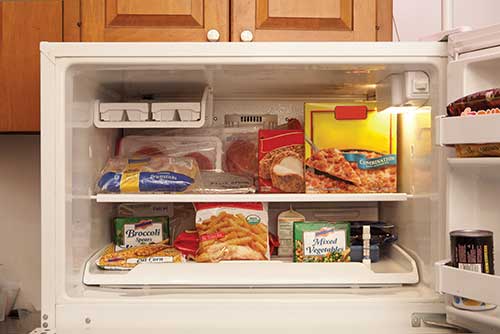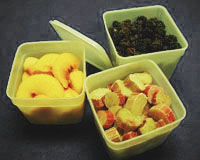Refrigerators
- Without power, refrigerators keep food cool for 4-6 hours depending on the temperature of the kitchen.
- Do NOT open the refrigerator.
- Except to place a block of ice in a container in the refrigerator to keep food cooler.
- If you anticipate a long power outage, use insulated containers to transport food to a working cooler or refrigerator.
Freezers
- Do NOT open the freezer unnecessarily if power is interrupted or the freezer fails to operate properly.
- The food will stay frozen about 2 days if the freezer is filled with food and you keep the door closed. If the freezer is not full, group packages together so they stay cold longer.
- If you know the power may go off, turn the freezer control to the coldest temperature. If you might have several days without power, act quickly. Get dry ice and put it in the freezer before food starts to thaw.
- HINT: Locate a source for dry ice BEFORE the power goes out to reduce your stress! For a 20-cubic-foot, full freezer, 50 pounds of dry ice keeps food frozen about four days. If the freezer is only half-full, food may not stay frozen more than a day. With dry ice it may stay frozen for three days. To use dry ice, place cardboard on top of the food. Put the dry ice on top of the cardboard. Handle it with gloves and have the room well ventilated. Follow handling directions carefully. Caution: be certain of good ventilation in the room. Carbon dioxide gas can accumulate and cause loss of consciousness/asphyxiation.
- If power will be out more than a few days, transfer foods as quickly as possible to another freezer or a commercial locker.
- Do not put food out on the snow—the sun may cause warming.
Once the power is restored
- Check temperatures of food in refrigerator and freezer. Use a food thermometer to check food item. If perishable food is above 40℉, discard it.
- For frozen foods, look for ice crystals and check temperature.
- Never taste food to determine its safety!
What should not be refrozen?
Don't refreeze:
- Food that thawed completely, especially meat, poultry and seafood.
- Prepared, cooked foods such as pizza, hot dishes, stews and soups.
- Any food that has poor or questionable color or odor.
- Thawed vegetables.
- Creamed foods, pudding or other low-acid foods that have thawed.
- Melted ice cream.
What is safe to refreeze?
You can refreeze:
- Foods that still contain ice crystals.
- Thawed fruit if it still smells good.
- Bread, cake, cookies and plain doughnuts.
- Nuts, flour and cereal.
- Raw meat and poultry that is still 40 ℉ or less.
- Juice.
- Margarine and butter.
- Cheese.
For more information, call AnswerLine at 800-854-1678 or read more about refreezing food.
Sources
- USDA Food Safety and Inspection Service. A Consumer's Guide to Food Safety: Severe Storms and Hurricanes
Related resources
- North Dakota State University. Food Freezing Guide.
Reviewed in 2021




